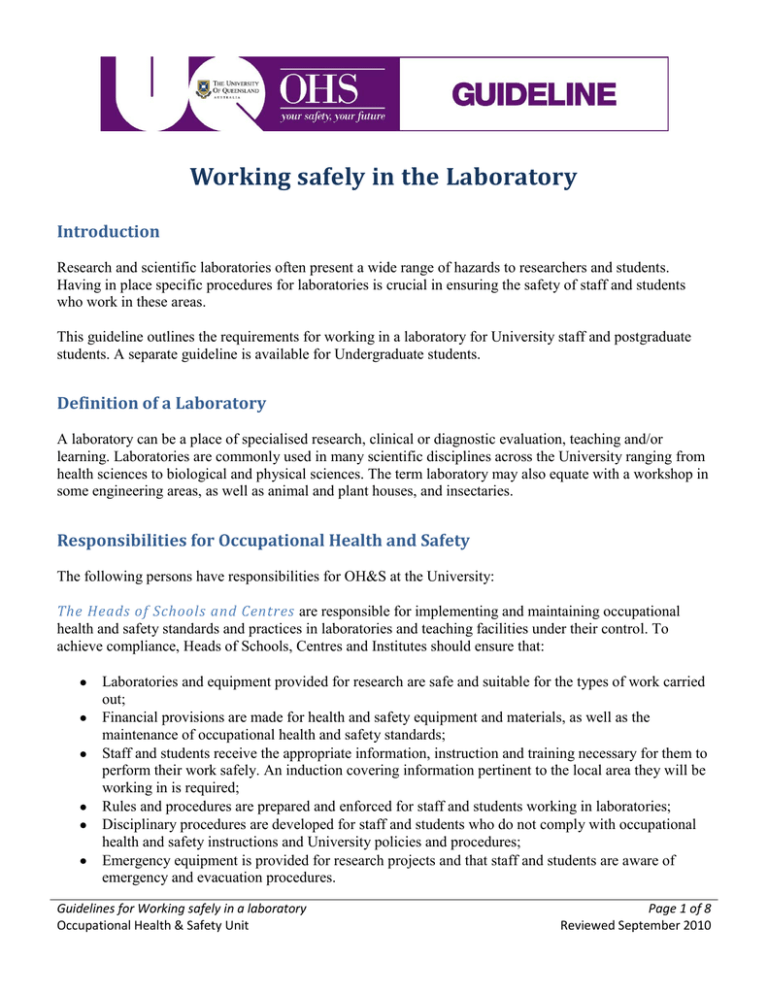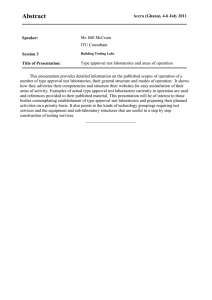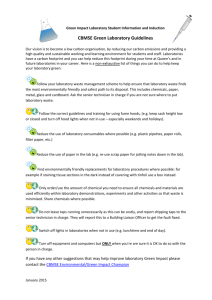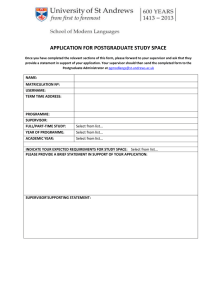Working safely in the Laboratory
advertisement

Working safely in the Laboratory Introduction Research and scientific laboratories often present a wide range of hazards to researchers and students. Having in place specific procedures for laboratories is crucial in ensuring the safety of staff and students who work in these areas. This guideline outlines the requirements for working in a laboratory for University staff and postgraduate students. A separate guideline is available for Undergraduate students. Definition of a Laboratory A laboratory can be a place of specialised research, clinical or diagnostic evaluation, teaching and/or learning. Laboratories are commonly used in many scientific disciplines across the University ranging from health sciences to biological and physical sciences. The term laboratory may also equate with a workshop in some engineering areas, as well as animal and plant houses, and insectaries. Responsibilities for Occupational Health and Safety The following persons have responsibilities for OH&S at the University: The Heads of Schools and Centres are responsible for implementing and maintaining occupational health and safety standards and practices in laboratories and teaching facilities under their control. To achieve compliance, Heads of Schools, Centres and Institutes should ensure that: Laboratories and equipment provided for research are safe and suitable for the types of work carried out; Financial provisions are made for health and safety equipment and materials, as well as the maintenance of occupational health and safety standards; Staff and students receive the appropriate information, instruction and training necessary for them to perform their work safely. An induction covering information pertinent to the local area they will be working in is required; Rules and procedures are prepared and enforced for staff and students working in laboratories; Disciplinary procedures are developed for staff and students who do not comply with occupational health and safety instructions and University policies and procedures; Emergency equipment is provided for research projects and that staff and students are aware of emergency and evacuation procedures. Guidelines for Working safely in a laboratory Occupational Health & Safety Unit Page 1 of 8 Reviewed September 2010 Academic Supervisors are responsible for providing a healthy and safe environment for honours and postgraduate students. The following should be ensured: Risk management principles are applied to the research that staff and postgraduate students are engaging in. The risk assessment process, including controls to be adopted should be documented by the supervisor and the student; Safe work practices are developed and maintained at all times; Postgraduate students receive the appropriate information and supervision necessary for them to carry out their studies safely; Students are warned about particular hazards, and how to avoid, eliminate or minimise their exposure to them; Proper attitudes towards health and safety are practiced and transferred to the student; Students under their control are using safety equipment provided in the correct manner, Good housekeeping standards are developed and maintained in the areas under their control; All students understand the disciplinary procedures that will be invoked for non-compliance with occupational health and safety instructions and University policies and procedures; Accidents and Incidents are recorded on the UQ Workplace Injury, Illness and Incident Report Form Staff and Postgraduate Students also have responsibilities under section 36 of the Workplace Health and Safety Act, 1995. Staff and postgraduate students are required to: Avoid, eliminate or minimise hazards of which they are aware; Comply with all occupational health and safety instructions, University policies and procedures including School or Centre OH&S manuals; Make proper use of all safety devices and personal protective equipment; Not wilfully place at risk the health and safety of themselves or any other person; Seek information or advice where necessary, or when in doubt, before carrying out new or unfamiliar work (this includes operating unfamiliar equipment); Wear protective clothing and footwear, as prescribed by the School, Centre or Institute Workplace Health and Safety Officer and the supervisor; Comply with University policy that food or drink are not to be consumed within the laboratory; Be familiar with emergency and evacuation procedures, including the location and use of emergency equipment such as safety showers and eyewash facilities; Report any medical conditions or allergies that could put them at risk during the conduct of their research to their supervisor; Report and record all accidents and near miss incidents. Induction - Introducing health and safety to staff and postgraduate students Each School/Centre/Institute and Division at the University must ensure that staff and postgraduate students attend an induction program on commencement of their employment or research project. The induction program should be carried out as soon as possible after the researcher commences their work or studies and attendance should be compulsory. It is essential that induction in any practical skills required for the studies is included in the program, and that this practical demonstration/instruction be given before the laboratory Guidelines for Working safely in a laboratory Occupational Health & Safety Unit Page 2 of 8 Reviewed September 2010 work commences. The Induction checklist for new staff must be completed by the staff member or postgraduate student http://www.uq.edu.au/ohs/pdfs/OHS-NewWorkerInduction-DRAFT.pdf. In addition to this local area/hazard specific induction, the on-line Laboratory Safety Module must also be completed. http://www.elearn.com.au/uq2/START.htm The Workplace Health and Safety Act requires that the employer discharges their health and safety obligation through the provision of training, instruction and supervision. The induction program should be seen as the first step in the development of skills by the student. Following the induction program, the supervisor must ensure that the student demonstrates proficiency at the skill(s) required before allowing them to complete the tasks without direct supervision. Changes to established procedures should be verified with the supervisor. Risk Assessments Risk Assessments must be completed for all Tasks being undertaken within the laboratory, and for all Hazardous Substances being used in the laboratory. You should not commence work in the Laboratory until you have completed a Risk Assessment for your experiments using the online Risk Assessment Database. Training on the operation of these databases is run regularly and course dates can be found at http://www.uq.edu.au/staffdev/index.asp?ProgramType=PE6OHS&Program=PEOWS&Course=OWS010 Risk Management is an ongoing process. Workplace hazards and risks should be reviewed at least once every year to ensure Risk Assessments – and the controls in place to manage identified hazards and risks – are comprehensive, relevant and up-to-date. Laboratory Safety Rules General rules – Laboratory Food and drink (including drinking from water bottles) must not be consumed in laboratories Unauthorised entry or experimentation in the laboratories is strictly forbidden; Staff and Postgraduates wishing to use the laboratory out of normal work hours must obtain their supervisor and the laboratory managers permission; All researchers must be aware of the conditions required for the safe handling of substances and specimens being handled; Be aware of the safety facilities of the laboratory, ie location of safety showers, eyewash stations, fire extinguishers and emergency exits; Working spaces are to be kept clean. Broken glass, sharps, and laboratory waste must be placed in the marked bins in the laboratory. No waste is to be left or placed in the sinks, and under no circumstance must waste be placed down the sink, unless authorised to do so under the Brisbane City Council sewerable limits guide http://www.uq.edu.au/ohs/pdfs/OHYG-BCC-TradeWasteGuide.pdf ; Disposable gloves should be placed into yellow bins (Clinical waste bin) which are specifically marked for such; Guidelines for Working safely in a laboratory Occupational Health & Safety Unit Page 3 of 8 Reviewed September 2010 All spillages must be cleaned up immediately after they occur; Be aware of burning bunsen burner by noting a hollow burning sound and/or the absence of a blue cone of unburnt gas; No samples are to be taken from, or brought into, the laboratory without the permission of your Supervisor or the Laboratory Manager Pipetting by mouth is strictly prohibited; Handle dissecting equipment with care, store blades covered, secure blades inside the dissecting kit and always remove blade from handle using wall-mounted scalpel blade remover; Defective equipment or broken glassware must be reported to the laboratory manager; Radioactive sources (e.g. laser, UV radioactive substance or arc lamp) must only be used following the direction and supervision of the supervisor or laboratory manager or radiation safety officer. Sitting on laboratory benches is prohibited. Never run in the laboratory or along corridors. Exercise care when opening and closing doors to laboratory; Cover any open wounds e.g. cuts, dermatitis on hands; Always wash hands thoroughly before leaving the laboratory. General rules – Laboratory dress code Personal Protective Equipment (PPE) is widely recognised as a means of protection for individuals working in an environment where all other methods of hazard control are in place and there is still a risk of injury. You must remember that PPE is the last barrier or line of defence between you and the hazardous material you are working with. The minimum PPE you are required to wear when working in University Laboratories are: Enclosed Shoes (no bare feet, thongs, or sandals and Lab Coat (must be individually issued, worn at all times when working in the lab, removed before leaving the lab and laundered regularly and when contamination is suspected). AQIS Note: If you have been working with Quarantine materials, your lab coat must be autoclaved prior to being removed from the lab and laundered The following additional PPE is provided and should be used where required / instructed / determined by a risk assessment: Safety Glasses / Goggles Gloves Dust Mask / Respirator Face Shield PVC Apron Hearing protection Eye Protection The type of eye protection required for a worker or student at the University will depend on the hazards that they work with or which they encounter in the specific work activity, and should be determined by undertaking a risk assessment. The risk assessment should take account of the hazards that are present in the laboratory for most of the time, and consider the work of the group as a whole, not just that of an individual. Guidelines for Working safely in a laboratory Occupational Health & Safety Unit Page 4 of 8 Reviewed September 2010 Safety Glasses must be worn when: There is a risk of objects striking or causing damage to your eyes. When instructed to do so by your Supervisor or the Lab Manager. If required by the Risk Assessments or Chemical MSDS. ** Safety Glasses may limit, but will not prevent chemicals from splashing into your eyes. Safety Glasses are only suitable when the chemicals you are working with would not harm your eyes in the event of an accident. Safety Goggles must be worn: When working with hazardous chemical solutions where there is a risk of splash to your eyes. Face Shield must be worn when: Working with volatile hazardous chemical solutions (eg. concentrated acids). Working with dangerous substances that could strike/splash the face/eyes. There is a risk of solution explosion or instability causing a splash to the face/eyes. There is a risk of dangerous objects striking the face/eyes, such as particles, glass or metal shards. Standard Prescription Glasses are not sufficient as protective eyewear if: You are working with hazardous chemical solutions and there is a risk of splash to the eye. You are working with toxic, corrosive, pathogenic or radioactive substances. You are undertaking activities where there is a risk of objects striking the eye, such as particles, glass or metal shards. ** In these instances, ordinary prescription glasses will not provide adequate protection from injury to the eyes and could even be hazardous to the wearer. Please see the Laboratory Manager if you require Prescription Safety Glasses. Additional information can be found in the UQ Document “Policy on Eye Protection in Laboratories”. Gloves Different gloves are available for different tasks. Please ensure that you are using the right type of glove for the task you are undertaking. For chemicals, this information can be found in the MSDS. Gloves available in this laboratory include: Latex disposable examination gloves – powder free o Protects your cultures / samples from you. o Helps stop the spread of some contaminates around the laboratory. o Not to be used with hazardous chemicals. Nitrile disposable gloves (blue) o Resistant to many solvents and chemicals. o Abrasion and puncture resistance. o Helps protect you from exposure to some hazardous chemicals. Rubber gloves o Good resistance to detergents and diluted chemicals. Guidelines for Working safely in a laboratory Occupational Health & Safety Unit Page 5 of 8 Reviewed September 2010 Cotton gloves o For use under other gloves – absorbs perspiration and helps with heat resistance (for eg, against hot dishwashing water). Leather gloves o Some protection when handling broken glass – extreme care must still be taken. Heat resistant gloves o Enables you to handle hot items – extreme care must still be taken. o Used to remove items from the Drying Ovens and/or Autoclave. Immunisation All staff and students should check that their tetanus immunization is current. If unsure, visit the University Health Service Staff and Students who come in contact with human blood or blood products are strongly advised to have a course of Hepatitis B immunisation Staff and Students who are in contact with sheep, goats, cattle, feral animals should have Q Fever vaccination. Staff and Students who are in contact with bats should have rabies immunisation These services and further advice on immunisation are all available through the University Health Services. First Aid All accidents must be reported immediately to the supervisor/laboratory manager and recorded on the Injury, Illness and Incident Database at http://www.risk.admin.uq.edu.au/uqinjury/forms/default_content.asp. Non injury causing incidents such as spills, electrical shorts etc must also be reported and recorded. First aid must be administered by trained first aid officers. Eye injuries, whether caused by chemicals or mechanical injury or splash with biological material, eye injuries are always serious. The treatment requires immediate and prolonged flushing with water (20 minutes minimum) at the eyewash station. Medical advice should be obtained for an eye injury.. In the event of chemical or biological spills on the skin, the affected area must be washed with copious quantities of water. Sharps injuries – Notify supervisor/lab manager immediately. Wash the wound and encourage bleeding. Seek medical treatment. Animal bites – Notify supervisor/lab manager immediately. Wound must be rinsed well. Tetanus immunisation should be up to date. Guidelines for Working safely in a laboratory Occupational Health & Safety Unit Page 6 of 8 Reviewed September 2010 Consult the Material Safety Data Sheet (MSDS) to determine appropriate first aid and print off the MSDS to accompany the researcher if necessary to seek further medical treatment. If you are feeling unwell or dizzy when participating in an experiment, stop immediately, sit down and notify supervisor/lab manager. Health surveillance Substances for which health surveillance should be provided if the risk assessment shows that the risk is significant include: MOCA Asbestos Cadmium Crystalline Silica Inorganic Chromium Isocyanates Lead Pentachlorophenol (PCP) Thallium Acrylonitrile Benzene Creosote Inorganic Arsenic Inorganic Mercury Organophosphate Pesticides Polycyclic Aromatic Hydrocarbons (PAH) Vinyl Chloride Further information on health surveillance and what steps you next to take to arrange for testing, refer to the Guideline for Health Surveillance for Schedule 8 substances http://www.uq.edu.au/ohs/pdfs/OHYGHealthSurveillance.pdf The researcher must also be advised of any required vaccinations and health surveillance checks if working with animals. Working Alone Work commitments and the need to share facilities may mean that some researchers need, or choose to work outside of normal working hours. When working after hours, the risks of some hazards may be increased due to the reduction in immediate assistance in the event of an accident or incident. There may be a reduced presence of trained emergency personnel during these hours; these include: first aid officers, floor wardens, staff of the OH&S Unit or the University Health Service. Australian Standard AS2243.1:2005 Safety in Laboratories – Planning and Operational Aspects states that where the risk assessment identifies high risk, these tasks shall not be undertaken by personnel working in isolation. Examples of high risk activities include: • Operating equipment or machinery, including workshop machinery, capable of inflicting serious injury, such as chainsaws, firearms, lathes and power saws. • Handling venomous reptiles, insects, arthropods or fish. • Working with large animals other than for the purpose of feeding or observation. • Working with, or near, toxic or corrosive substances where there is a significant risk of exposure Guidelines for Working safely in a laboratory Occupational Health & Safety Unit Page 7 of 8 Reviewed September 2010 to the substance, taking into account the volume used. • Using apparatus that could result in explosion, implosion, or the release of high energy fragments or significant amounts of toxic or environmentally damaging hazardous material. • Climbing towers or high ladders. • Working with exposed energized electrical or electronic systems with nominal voltages exceeding 50 V a.c. or 120 V ripple-free d.c.(NOTE: These limits are for dry, indoor conditions and a more conservative approach should be taken in other conditions.) • Working with radionuclides requiring a high level laboratory in accordance with AS 2243.4 for Australia and the National Radiation Laboratory Code of safe practice for the use of unsealed radioactive materials. • Working with microorganisms of Risk Group 3 and higher, or which require the use of a Containment Level 3 facility or higher containment level in accordance with AS 2243.3. • Operating lasers of Class 3 and above [except where fully enclosed and approved by the UQ Radiation Safety Adviser]. • Working in environments not at atmospheric pressure where there is a risk of low oxygen or a toxic atmosphere. If any of these designated high risk activities are conducted outside of normal working hours, the Guideline for Working after hours or in isolation must be followed, including approval from the supervisor and a written risk assessment. Pregnancy The University has a responsibility to advise all researchers of any health and safety risks relevant to their research. Staff or students who are pregnant may be at higher risk from exposure to certain chemicals and other hazards. When the researcher commences work or research at the University, the supervisor should advise if there is any known risk of exposure to teratogenic or reproductive hazards . This ensures that suitable arrangements or modifications can be made to minimise their exposure, if they are known to be pregnant or are trying to fall pregnant. This also applies to males where some substances and hazards are known to affect male reproductive organs. Other information The Australian Standard series, Safety in Laboratories – Parts 1-10) can also be referenced to obtain more specific information relating to laboratory safety AS2243.1 (2005) Safety in Laboratories – Planning and Operational Aspects AS2243.2 (2006) Safety in Laboratories – Chemical aspects AS2243.3 (2002) Safety in Laboratories – Microbiological aspects and containment facilities AS2243.4 (1998) Safety in Laboratories – Ionising Radiation AS2243.5 (2004) Safety in Laboratories – Non-Ionising radiation AS2243.6 (2010) Safety in Laboratories – Plant and equipment aspects AS2243.7 (1991) Safety in Laboratories – Electrical aspects AS2243.8 (2006) Safety in Laboratories – Fume cupboards AS2243.9 (2009) Safety in Laboratories – Recirculating fume cupboards AS2243.10 (2004) Safety in Laboratories – Storage of chemicals Guidelines for Working safely in a laboratory Occupational Health & Safety Unit Page 8 of 8 Reviewed September 2010


